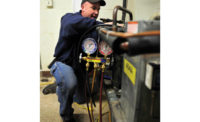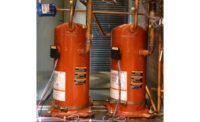Continuous and rapid (short) cycling of a compressor can lead to its premature failure. Each time a compressor starts, it consumes an abnormally high current until it gets close to its normal operating speed. This is commonly referred to as its locked rotor amperage (LRA). This high current also causes the compressor’s windings to increase in temperature. Since this inrush current is only momentary, the increase in temperature is not an issue. Once the compressor starts to run at its normal speed and amperage, the winding will cool down and run at normal operating levels.
However, if the compressor quickly shuts down and then restarts, the short run time and off time may not allow the winding’s temperature to cool down. Each time the compressor starts, the winding temperature increases a bit, and if left unchecked, it could lead to the compressor’s windings increasing to an unsafe level, resulting in damage. Also, each time the compressor starts, the bands around the windings are stressed. This is not normally an issue, but coupled with a higher winding temperature and rapid starting, it can lead to their damage as well.
When there is a system issue that leads to short cycling of a compressor, the case temperature will increase, which will normally be noticed by the equipment owner. However, if no one is around to notice the temperature increase, the compressor will continue to short cycle for a very long time, which can lead to its failure. At that point, the owner is faced with two repair issues: the one causing the rapid cycling of the compressor and the damaged compressor.
During this scenario, it may be possible to prevent damaging the compressor. Adding a simple time delay relay to the control system can help avoid short cycling of the compressor. Each time the compressor shuts down, it is held off for three to five minutes before restarting. This allows the windings to cool down a bit before the compressor tries to start again. Many new systems already incorporate a compressor time delay relay as part of its control system, but some do not. During a repair, adding a time delay relay to the compressor’s control system can save thousands on future repairs.
There are two basic types of time delay relays: delay on make and delay on break. The delay on make begins the timing period when power is applied to the time delay and is typically used for staging of components to allow for a delay before energizing various loads. The delay on break begins the timing after the load is de-energized and is typically used to prevent short cycling.
While a time delay relay may be incorporated in some electronic temperature controls used today, their delay only occurs when the temperature control closes, which may not adequately protect the compressor. A better time delay relay is connected in series with other compressor safeties so that if one of the safeties opens, a time delay will occur before the compressor restarts. A time delay relay may not prevent all compressor failures but it can prevent some. For the small investment, it is worth the additional expense to your customers.






Report Abusive Comment